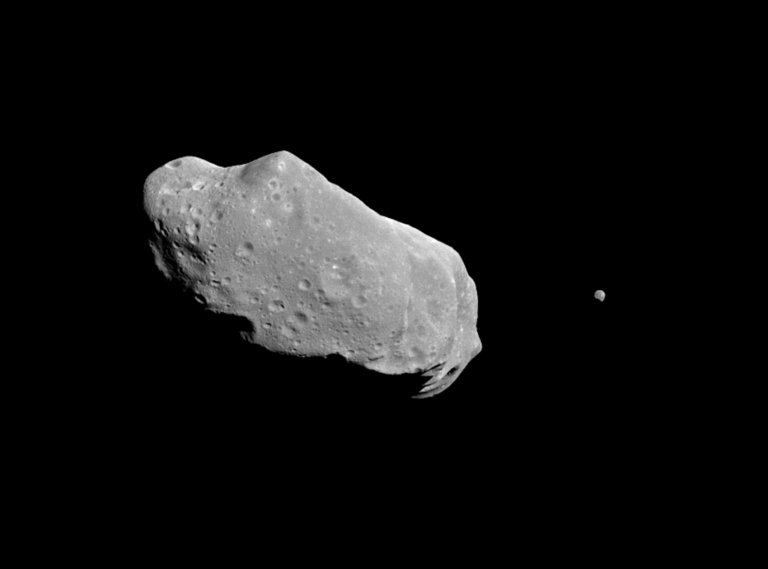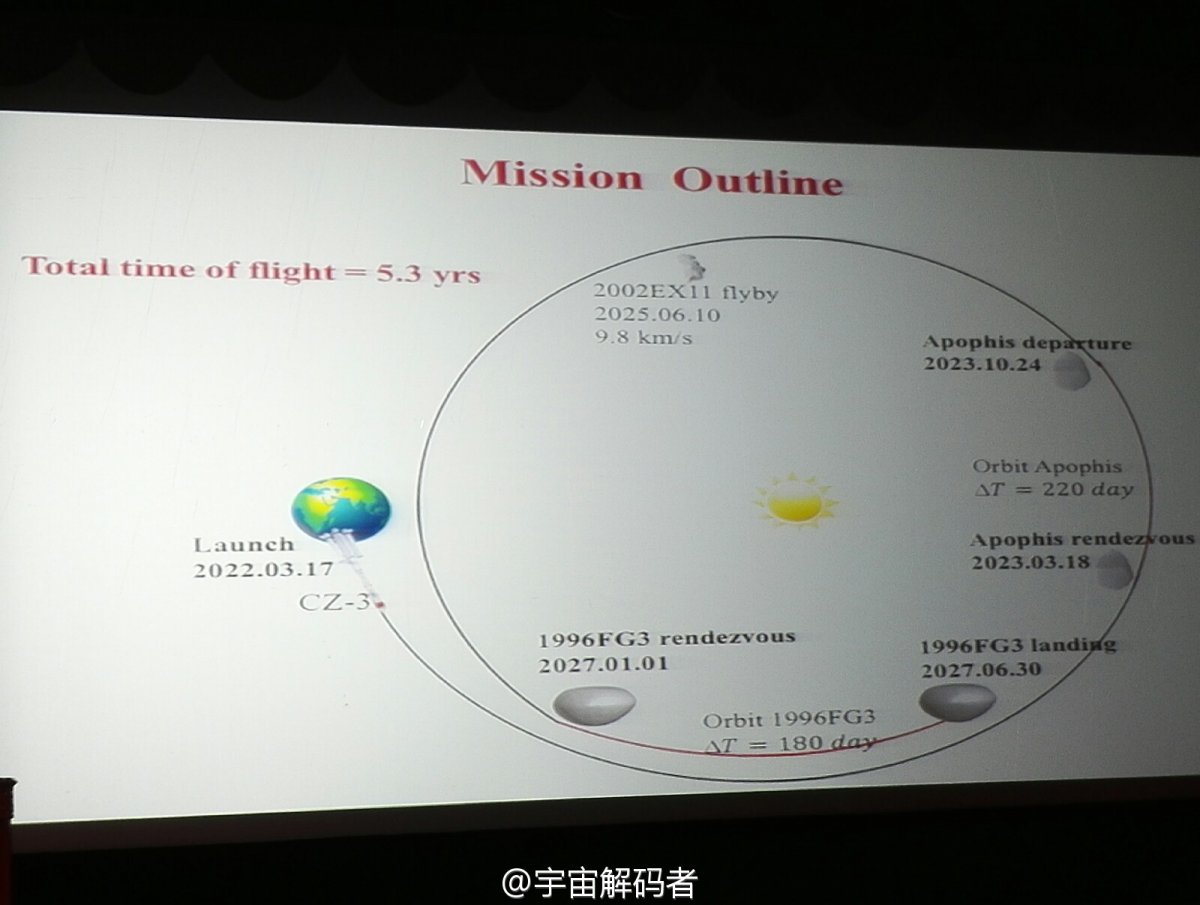

The first full picture showing both asteroid 243 Ida and its newly discovered moon to be transmitted to Earth from NASA's Galileo spacecraft in 1996 - the first conclusive evidence that natural satellites of asteroids exist. (Photo: NASA/JPL)
Leading figures involved in China's space programme are looking at a range of ideas for utilising asteroids and other small bodies, including resource extraction, learning about the origins of the solar system - and even escaping from it - but such activities are a long way off.
Speaking at an asteroid exploration forum in Beijing on Monday, Ye Peijian, a senior deep space scientist, said that China will in the future "study ways to send robots or astronauts to mine suitable asteroids and transport the resources back to Earth."
While this sounds exciting, it is a far cry from a declaration of a 'space race' with other space-faring nations and private ventures to mine asteroids, and has been widely misinterpreted or exaggerated in press reports.
First, there is a huge gap between studying missions and proving their feasibility, gaining backing, developing the capabilities, and acquiring approval. Second, China, which already has a comprehensive space programme, has committed serious resources to constructing a large, modular space station in low Earth orbit, likely starting around early 2019 with the launch of the Tianhe core module.
China's robotic missions are also still very much focused on the Moon, with the launch of the complex Chang'e-5 lunar mission in November this year and early work beginning on an expanded range of missions including polar exploration, with a Mars exploration project also taking shape.
There are also legal issues that need to be addressed before anyone starts profiting from space resources. That said, China does have a least asteroid mission likely to take off within the next decade.
Asteroid sample return
One practical step being taken by China in this realm is the development of a mission to flyby, track and collect samples from a near-Earth asteroid. Though not approved, it is understood that at least two teams are working on different variations of this, and at least one will be launched within ten years.
"We think first, it should not take long. After the Mars exploration mission (in 2020), we should do that before 2025. Second, we should aim high. That is to say, the probe should fly there, fly side by side with an asteroid, land on it, take samples, and return," says Ye.
Such a mission has already been outlined by Ji Jianghui, a researcher at Purple Mountain Observatory under the Chinese Academy of Sciences (CAS), which would first fly alongside and orbit near-Earth asteroid Apophis, then flyby asteroid 2002 EX11, and finally rendezvous with and land on asteroid 1996 FG3.
That itinerary is based on launch in early 2022, but the mission has not been formally approved. Ji says the mission aims to study the formation and evolution of asteroids, which could give insight into the origins of the solar system and the origins of life and water on Earth.

Above: A presentation slide for one Chinese near-Earth asteroid mission outline.
Ye Peijian notes that such a mission is very challenging, due to the long flight times and low gravity of the targets. "Problems like how to control their positions and distance as they fly side by side and how to land on it and take samples from it all need different solutions than what we do for a celestial body with gravitational force," says Ye.
But this may not be a pioneering mission. The European Space Agency drew great attention with the conclusion of its recent, spectacular Rosetta mission, while Japan has already returned particles from 25143 Itokawa with its Hayabusa probe. The more advanced Hayabusa 2 is currently on the way to asteroid 162173 Ryugu.
NASA's own asteroid sample return mission, OSIRIS-REx, is heading toward 101955 Bennu, with return to Earth expected in 2023.
China has already conducted one flyby observation of an asteroid, named Toutatis, in 2012 when the country's second lunar probe, Chang'e-2, rendezvoused with Toutatis at a distance of 770 metres after successfully completing its primary mission to orbit and map the Moon.
Interstellar plans?
The asteroid exploration forum in Beijing - including a ceremony to mark the naming of an asteroid 456677 Yepeijian - also gave rise to discussion of more creative visions for missions, with Mr Ye saying Chinese scientists and engineers are considering possibilities for the far future.
"In the long term, we will consider using resources from asteroids to build facilities in space or to provide materials to support interstellar travel," he said.
Given the lack of detail and capabilities, it's not yet worth looking too far into these or the human missions to asteroids, which will require a super-heavy launch vehicle and successor to the Shenzhou, but further information from the event can be found here (Chinese).
It's worth stating though that NASA has a mission concept, named Comet Hitchhiker, developed at the Jet Propulsion Laboratory, that seeks to use comets to allow it a probe to tour Kuiper belt objects.
Giving backing to Ye's words is the fact that 'asteroid exploration' is an area explicitly mentioned in "China's Space Activities in 2016", a government policy paper released in December which outlines the country's ambitions for space for the next five years and beyond.
Specifically it is more than likely referring to the sample return mission stated above, which would occur during the next Five Year Plan period, but it indicates that asteroids are on China's radar.
Even so, there are great challenges to asteroid exploration, and not just those that are technical and engineering in nature.
Legality of utilising space resources
The notion of utilising space resources from bodies such as asteroids has attracted a lot of attention, both from nation states and private entities, with a number of the latter aiming to commercially exploit space resources, such as Deep Space Industries and Planetary Resources.
The legality of prospecting and exploiting resources from solar system bodies is uncertain at best, however. While the Outer Space Treaty of 1967 states that "outer space is not subject to national appropriation by claim of sovereignty, by means of use or occupation, or by any other means" - effectively barring nation-states from such activity - there is disagreement as to how this applies to private entities.
Somewhat controversially, a US domestic law passed in 2015 allows US citizens to "engage in the commercial exploration and exploitation of 'space resources' [including ... water and minerals]". There is however nothing approaching international consensus on whether this would be legal, and such a move would likely face strong resistance as things stand.
With all of this activity and potential, there will be much interest in China's first space law, expected to be drafted and passed within the current Five Year Plan period (2016-2020), with regard to its position on the utilisation of space resources. This could be the first true indication of China's long-term intentions. (GBTimes)

86-10-68597521 (day)
86-10-68597289 (night)

52 Sanlihe Rd., Xicheng District,
Beijing, China (100864)

